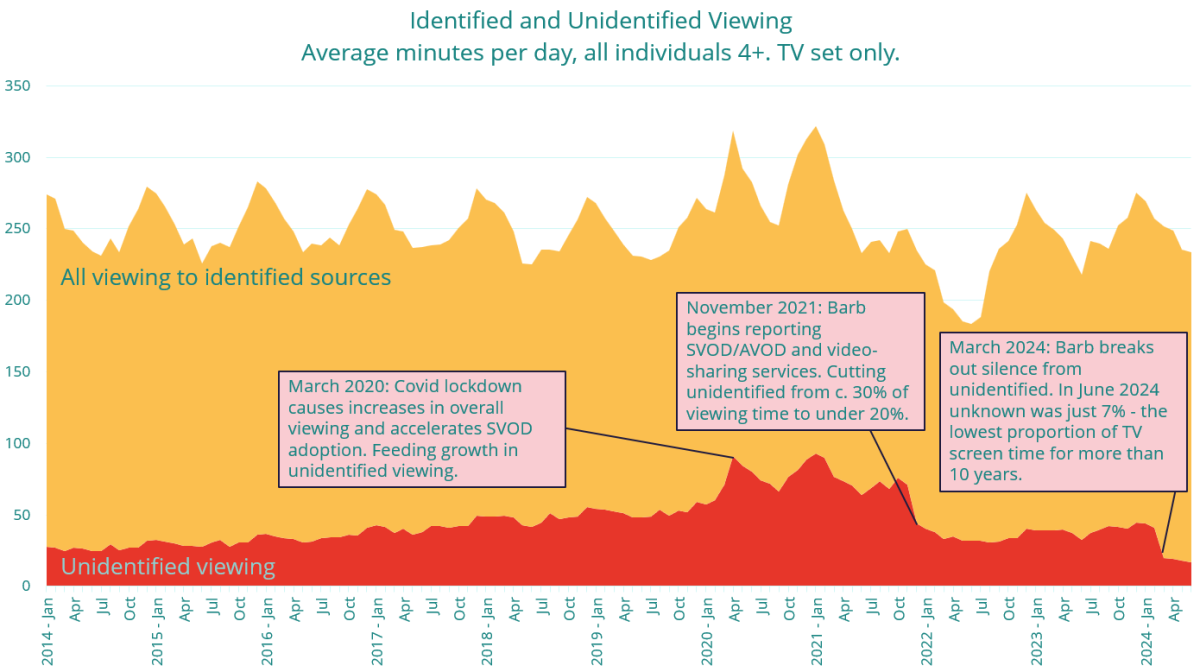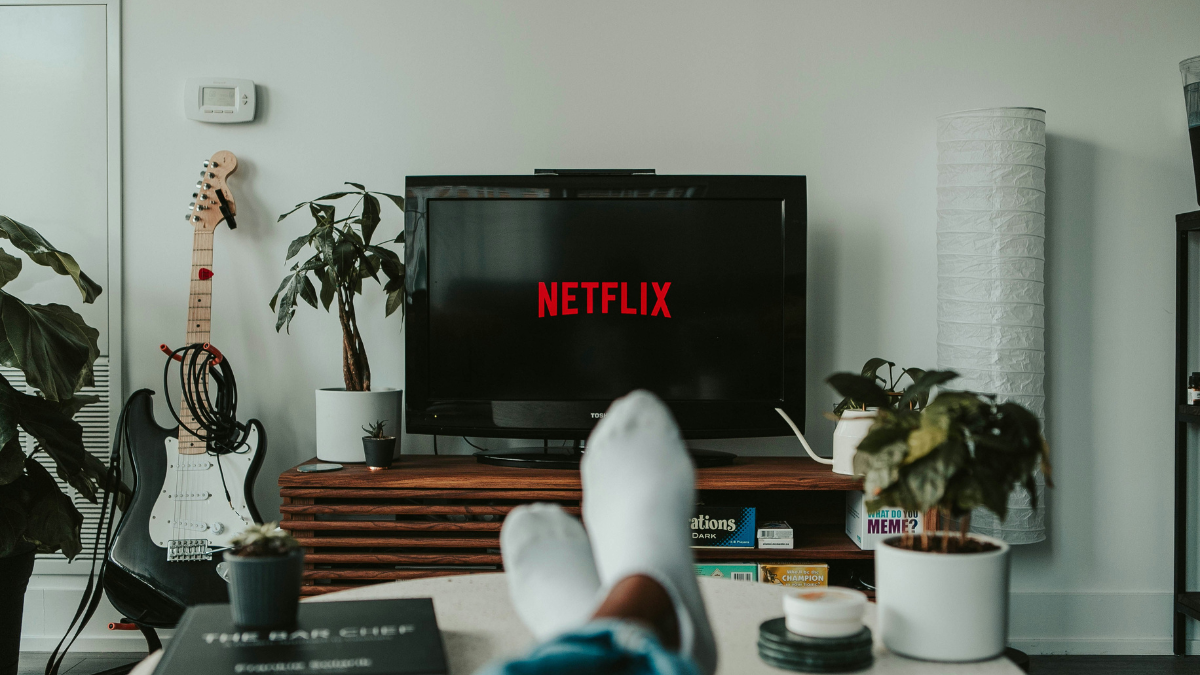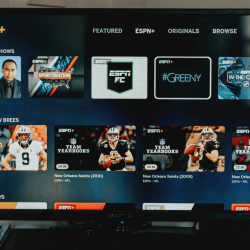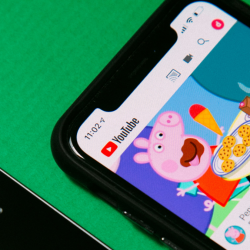There are known knowns, known unknowns and unknown unknowns. Donald Rumsfeld famously discussed known unknowns when talking about US national security, but the same can be said about TV viewing. Some things are known — a peak of 2m watched the closing ceremony of the Paralympics on Channel 4 capping a wonderful Games from Paris. Then there are known unknowns — YouTube achieved a peak TV set audience of 1.8m on the same day. So, we know how many people were watching YouTube, but the content is unknown.
Then there are unknown unknowns. Sticking with Sunday 8 September, the peak TV set audience to ‘unknown’ content was 2.4m. One thing we do know is that unknown as a category of viewing has long been a challenge for Barb. But, in a world where reaching engaged audiences on the TV set is getting more complex, there are some potential big wins for broadcasters and advertisers in turning some of those unknowns into knowns.
Advances in understanding unknown have been significant in recent years

If we go back to 2014, unknown viewing was just 10% of time that Barb was reporting with the TV set. At this point, we also began tracking the advance of SVOD services via our Establishment Survey. As we saw access to such services grow over time so unknown viewing minutes had grown with almost perfect correlation. Finally accelerated by the lockdowns that accompanied the Covid pandemic, unknown viewing reached around 30% of time with the TV set in 2020 and 2021 for all individuals. And was even higher for younger demographics.
This put us firmly in the realm of a known unknown. The use of SVOD services was clearly a big part of the observed increase. What we didn’t know though was just how much time audiences really were spending with the likes of Netflix. With such a clear target work was well underway to bring this viewing into the light. In late 2021 viewing figures were produced for Netflix and a slew of other services — even before they became Barb subscribers.
Consequently, unknown viewing dropped sharply. It had averaged 71 minutes per day for all individuals aged 4+ in November 2021 and fell to 44 minutes the following month. Further refinement saw this drop to an average of 34 minutes over 2022, before ticking up again to 39 minutes for 2023.
The quest to unpack unknown then continued. With a less obvious target than revealing time with SVOD services, we had to question the way in which people use their TV sets.
Searching for something to watch is often accompanied by silence
Most of us will know from our personal viewing habits that the journey to finding something to watch can be torturous. A scroll through the EPG might be followed by a hop-scotch through various different apps. And that’s before you try and get everyone to agree.
This journey is often accompanied by silence on the TV set. That’s all well and good, but how could we go about defining and measuring silence? It almost sounds like a philosophical question.
If someone plays an episode of Bridgerton, but no one is in the room to hear it does it really make a sound? Well, yes. The meter attached to the TV set tells us it does. Although if no one is in the room to hear it the viewing will, of course, not count.
But it is the meter that makes the detection of silence possible. New meters were rolled out to the entire panel by late 2023. They listen for programme audio and inaudible watermarks. They also detect SI and SK codes from Sky set-top boxes. Another meter, attached to the WiFi router, is checking to see if content is being served via IP. If these meters detect none of this, but they do see that the TV set is on, silence is registered.
Profiling silence helps everyone to better understand the nascent pause ads space
As with any new classification, people are keen to know what is included within silence. While we can’t answer that definitively, we know the kinds of things that will feed silence. We’ve discussed EPG use and time within app home screens above. Game play with no audio would also be reported as silence.
More relevantly, perhaps, is the pausing of content. Including live, on-demand or recorded playback. The proliferation of pause ads, pioneered by Channel 4 some years ago, makes this potentially useful. While recognising that not all silence is pausing, by profiling this audience we can get a steer on the kinds of people that pause content. When they are likely to do it and within which content — all very helpful for advertisers and their agency partners when deciding where to best place their pause ads.
A number of recent studies into the way viewers navigate their way to content paint a picture of consumers spoilt for choice. That choice though can be overwhelming. Consumers know there is great content available — the unknown for them is where it is, or how to find it. Unpacking a fundamental part of TV set use, like silence, is really useful for broadcasters, advertisers and their agencies who are constantly looking for ways to keep viewers engaged with their content.
And pause ads are just one feature that silence could capture. Time spent within On-demand app Operating Systems from the likes of ITVX and Channel 4 streaming represents an expanding canvas for advertisers to engage with audiences.
Knowing feeds the desire to know more
We can see the impact of removing silence from unknown in the chart. In March this year, there was another step change in the average minutes with the TV set classified as unknown. The average minutes fell by just over half from 41 minutes per day in February to just under 20 minutes in March.
The progress made in reducing unknown time with TV sets is gratifying, but this is a never-ending process. We have a great content-level understanding of viewing to the main SVOD services. Extending that to cover 4-screens would be ideal.
Knowing how many people are using YouTube, for how long and who they are is a step in the right direction. Revealing the known unknown of what content they are watching is high on our to-do list.
Featured image: Mollie Sivaram / Unsplash































